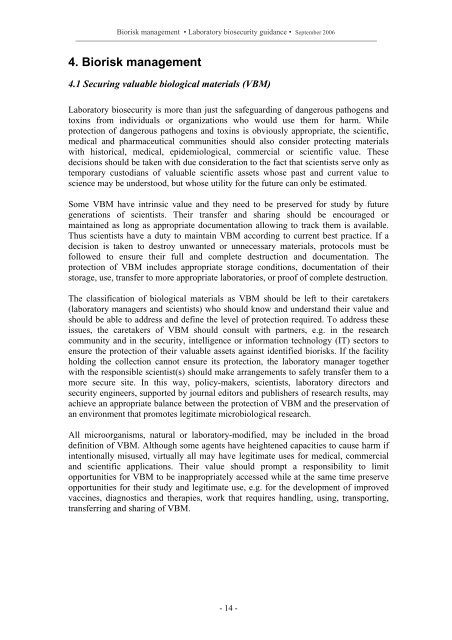Laboratory biosecurity guidance - World Health Organization
Laboratory biosecurity guidance - World Health Organization
Laboratory biosecurity guidance - World Health Organization
You also want an ePaper? Increase the reach of your titles
YUMPU automatically turns print PDFs into web optimized ePapers that Google loves.
Biorisk management • <strong>Laboratory</strong> <strong>biosecurity</strong> <strong>guidance</strong> • September 2006<br />
4. Biorisk management<br />
4.1 Securing valuable biological materials (VBM)<br />
<strong>Laboratory</strong> <strong>biosecurity</strong> is more than just the safeguarding of dangerous pathogens and<br />
toxins from individuals or organizations who would use them for harm. While<br />
protection of dangerous pathogens and toxins is obviously appropriate, the scientific,<br />
medical and pharmaceutical communities should also consider protecting materials<br />
with historical, medical, epidemiological, commercial or scientific value. These<br />
decisions should be taken with due consideration to the fact that scientists serve only as<br />
temporary custodians of valuable scientific assets whose past and current value to<br />
science may be understood, but whose utility for the future can only be estimated.<br />
Some VBM have intrinsic value and they need to be preserved for study by future<br />
generations of scientists. Their transfer and sharing should be encouraged or<br />
maintained as long as appropriate documentation allowing to track them is available.<br />
Thus scientists have a duty to maintain VBM according to current best practice. If a<br />
decision is taken to destroy unwanted or unnecessary materials, protocols must be<br />
followed to ensure their full and complete destruction and documentation. The<br />
protection of VBM includes appropriate storage conditions, documentation of their<br />
storage, use, transfer to more appropriate laboratories, or proof of complete destruction.<br />
The classification of biological materials as VBM should be left to their caretakers<br />
(laboratory managers and scientists) who should know and understand their value and<br />
should be able to address and define the level of protection required. To address these<br />
issues, the caretakers of VBM should consult with partners, e.g. in the research<br />
community and in the security, intelligence or information technology (IT) sectors to<br />
ensure the protection of their valuable assets against identified biorisks. If the facility<br />
holding the collection cannot ensure its protection, the laboratory manager together<br />
with the responsible scientist(s) should make arrangements to safely transfer them to a<br />
more secure site. In this way, policy-makers, scientists, laboratory directors and<br />
security engineers, supported by journal editors and publishers of research results, may<br />
achieve an appropriate balance between the protection of VBM and the preservation of<br />
an environment that promotes legitimate microbiological research.<br />
All microorganisms, natural or laboratory-modified, may be included in the broad<br />
definition of VBM. Although some agents have heightened capacities to cause harm if<br />
intentionally misused, virtually all may have legitimate uses for medical, commercial<br />
and scientific applications. Their value should prompt a responsibility to limit<br />
opportunities for VBM to be inappropriately accessed while at the same time preserve<br />
opportunities for their study and legitimate use, e.g. for the development of improved<br />
vaccines, diagnostics and therapies, work that requires handling, using, transporting,<br />
transferring and sharing of VBM.<br />
- 14 -

















